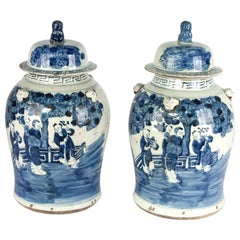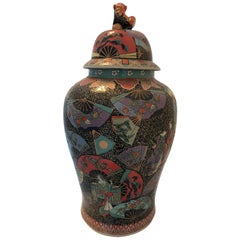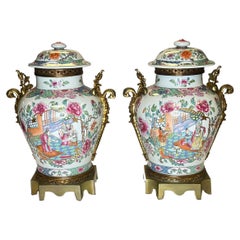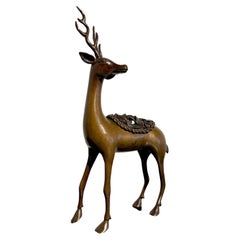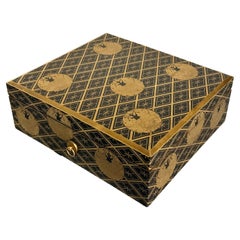Questions & Answers
Our trusted network of 1stDibs sellers answer common questions
What were Chinese ginger jars used for?
1 Answer
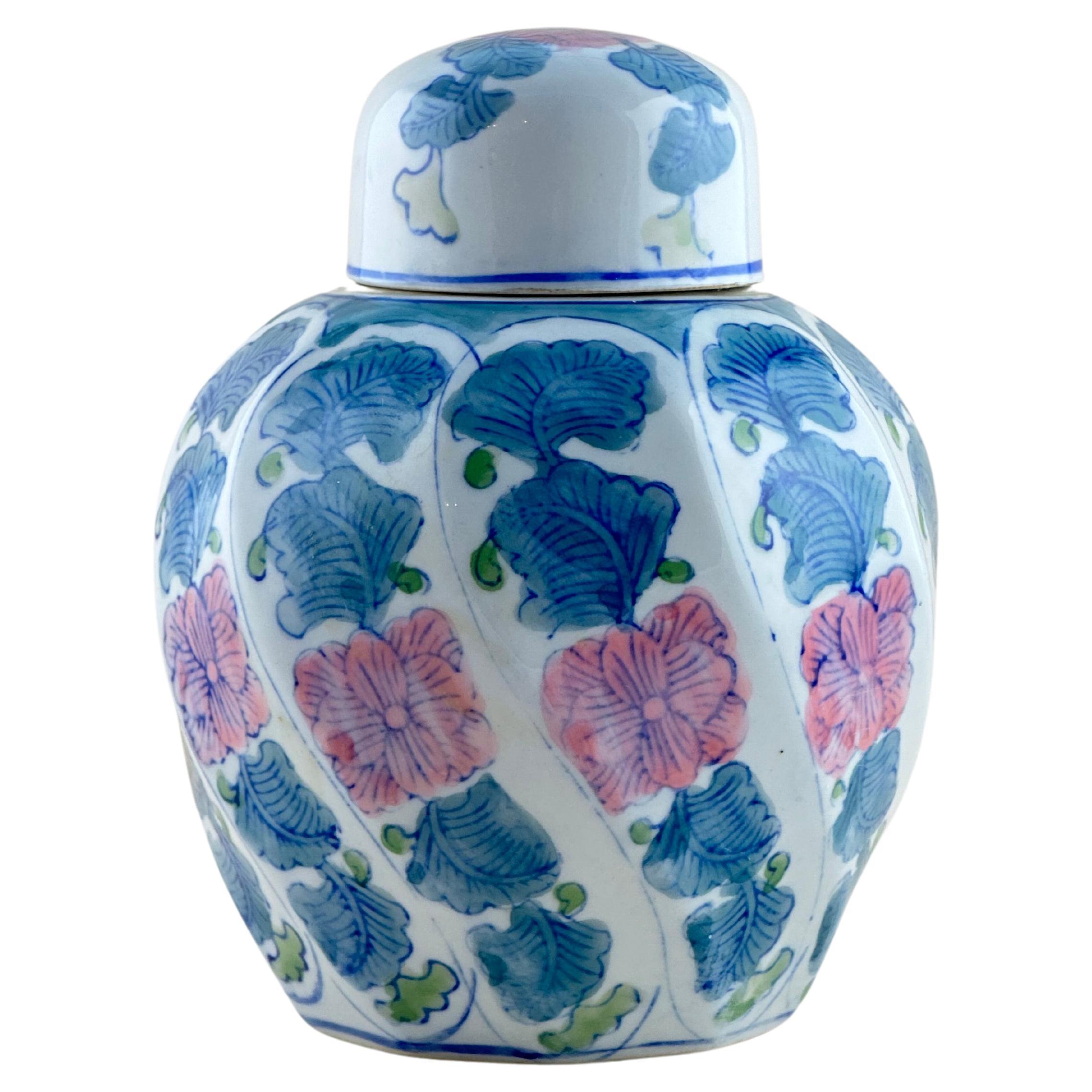
Chinese ginger jars were originally made as utilitarian vessels used to store various herbs and spices. Today, they are almost exclusively decorative objects.

Lotus GallerySeptember 23, 2020
Related Questions
- What are ginger jars?1 Answer
- Why is it called a ginger jar?1 Answer
- What are the defining factors of a Chinese ginger jar?1 Answer
- What does a Chinese ginger jar look like?1 Answer
- What is an apothecary jar?1 Answer
Shop for Chinese Ginger Jars on 1stDibs
18th Century Chinese Ginger Jars
Located in Esbeek, NL
Beautiful set of Chinese ginger jars
18th century or earlier.
Category
Antique 18th Century Chinese Jars
Materials
Porcelain
Chinese Ginger Jar with Foo Dog Topper
Located in Dallas, TX
This large 1950s Chinese ginger jar is made of many bright, contrasting and vibrant colors. The
Category
Vintage 1950s Chinese Jars
Materials
Porcelain
Pair Famille Rose Chinese Ginger Jars with Bronze Mounts
Located in New York, NY
Pair Famille Rose Chinese Ginger Jars with Bronze Mounts in Louis XVI Style.
Category
20th Century Chinoiserie Jars
Materials
Bronze
Mid-20th Century White and Blue Ceramic Chinese Ginger Jars
Located in Catania, Sicilia
Crafted in China during the mid-20th century, these ginger jars exemplify the classic blue and
Category
Mid-20th Century Chinese Chinese Export Jars
Materials
Ceramic
Colourful Vintage 'Straits Style' Chinese Ginger Jar
Located in Glasgow, GB
A large vintage 'Straits style' ginger jar. Crafted in China towards the latter half of the 20th
Category
Late 20th Century Chinese Qing Jars
Materials
Enamel
Small Vintage Chinese Ginger Jar Mille Fleur Style
Located in Glasgow, GB
A small porcelain ginger jar, crafted in China during the 1980s.
Hand-painted with the bright and
Category
1990s Chinese Qing Jars
Materials
Porcelain
Shop More furniture from Lotus Gallery on 1stDibs
Japanese Bronze Deer Incense Burner, Koro, Meiji Period, late 19th c, Japan
Located in Austin, TX
An elegant and ethereal Japanese bronze censer, koro, in the form of a deer, Meiji Period, late 19th century, Japan.
The deer is portrayed standing upon thin, spindly legs, one leg ...
Category
Antique Late 19th Century Japanese Meiji Sculptures and Carvings
Materials
Bronze
Kinkozan Satsuma Plate with Miniature Figures, Meiji Period, circa 1900, Japan
By Kinkozan
Located in Austin, TX
A very finely painted Japanese Satsuma plate with miniature figural paintings, signed Kinkozan for the Kinkozan workshops, Meiji Period, circa 1900, Japan.
The lovely plate crafted ...
Category
Antique Early 1900s Japanese Meiji Ceramics
Materials
Ceramic, Stoneware
Japanese Maki-e Lacquer Sutra Box with Peony Mon, Meiji Period, c 1900, Japan
Located in Austin, TX
A Japanese maik-e decorated black lacquer sutra box, kyobako, with peony mon design, Meiji Period, circa 1900, Japan.
The elegant lacquer box originally crafted to hold sutras, sacr...
Category
Antique Early 1900s Japanese Meiji Lacquer
Materials
Copper
Japanese Bronze Water Coupe, Eguchi as Fugen, Edo/Meiji Period, Japan
Located in Austin, TX
A very finely cast Japanese bronze water coupe in the form of the courtesan Eguchi riding an elephant, signed Kazutada, Edo to Meiji Period, mid 19th century, Japan.
The small and e...
Category
Antique Mid-19th Century Japanese Meiji Scholar's Objects
Materials
Bronze
Six Kinkozan Bowls with Birds and Flowers of the Months, Meiji Period, Japan
By Kinkozan
Located in Austin, TX
A very fine partial set of six Japanese Satsuma bowls decorated with flowers and birds of the months, signed Kinkozan, Meiji Period, circa 1900, Japan.
The set of six exquisitely pa...
Category
Antique Early 1900s Japanese Meiji Ceramics
Materials
Ceramic, Stoneware
Vintage Burmese Reclining Buddha, Carved, Lacquered and Gilt Wood, circa 1970's
Located in Austin, TX
A charming vintage Burmese Mandalay Style carved, lacquered, and gilt wood figure of a reclining Buddha, 1970's, Burma.
The delightful Buddha figure is portrayed resting comfortably...
Category
Vintage 1970s Burmese Sculptures and Carvings
Materials
Wood
Large Japanese Imari Fluted Charger, Edo/Meiji Period, Mid 19th Century, Japan
Located in Austin, TX
A large and impressive Japanese Imari porcelain fluted charger with scalloped rim, signed Kaji(chu?), Edo to Meiji Period, mid 19th century, Japan.
The magnificent Japanese Imari charger measures 25" in diameter, and is decorated in the typical imari palette of underglaze blue with overglaze red, orange, blue, and green enamels with gilt highlights. The large charger also features fluted sides and a scalloped gilt rim.
The design of the charger is centered on a central floral medallion with three large chrysanthemum blossoms and vegetal scrolls. Radiating out from the central medallion are various brocade patterned sections that roughly follow the shape of the fluting. Some larger sections feature images of cranes and minogame (turtles with long tails), both symbols of longevity, while other feature dragons and phoenix, symbols of authority and power. Four large reserves depict charming scenes of a scholar and his students within a bamboo grove having discourse and examining scrolls.
The back of the charger decorated in underglaze blue with bold floral and vegetal scrolls. With a three character inscription in underglaze blue reading Kaji(chu?) Sei.
The charger is fitted with an antique metal hanger...
Category
Antique Mid-19th Century Japanese Meiji Ceramics
Materials
Porcelain
